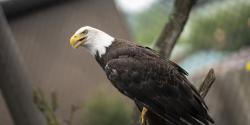The Wilds welcomed two litters of endangered pups in early February – one litter of dholes (the first ever to be born at The Wilds) and one litter of African painted dogs. Both species’ births were especially notable as they are considered endangered in their native ranges. The conservation center also celebrated the arrivals of four Sichuan takin calves in early March.
Two dhole pups were born to first-time parents, Csilla and Jetson, on February 5. Mother, Csilla (pronounced Chia), is five years old and came to The Wilds from the Minnesota Zoo in January 2017. Father, Jetson, is six years old and came to The Wilds from the San Diego Safari Park in June 2017.
Dholes (Cuon alpinus), also known as Asiatic wild dogs, are quite rare and are considered endangered in their native range throughout Central, South and Southeast Asia. According to the International Union for Conservation of Nature (IUCN,) dholes can sometimes be found in countries including India, Cambodia and Indonesia, but their populations are believed to have been extirpated in other regions due to habitat loss, disease, human persecution and depletion of their prey base. The Wilds is one of just three facilities in North America that houses dholes. As dhole populations in their native range continue to decline, the births of these two pups at The Wilds are especially significant additions to the future of this species.
A litter of nine African painted dogs, also known as African wild dogs, was born at The Wilds over the course of several hours on February 16. The pups were born to second-time parents, mom Quinn and dad, Onyx.
Quinn and Onyx are also the parents of The Wilds’ first litter of African painted dogs born in December 2016. Quinn came to The Wilds in spring 2016 after being born at the Cincinnati Zoo and Botanical Garden in 2015, while Onyx, age 8, came from the Honolulu Zoo in June 2016. Both litters of pups were the result of breeding recommendations from the Association of Zoos and Aquariums’ (AZA) Species Survival Plan® (SSP), which is coordinated to increase genetic diversity and population sustainability of threatened and endangered species in managed care.
Painted dogs (Lycaon pictus), also known as African wild dogs, are one of Africa’s most endangered species. These dogs have disappeared from much of their former range throughout sub-Saharan Africa, and their populations are continuing to decline; researchers estimate that less than 6,000 painted dogs are left in their native regions. Challenges with humans are the main threats to their survival, and the painted dog populations have declined due to continued habitat fragmentation, conflict with human activities and infectious disease, according to the IUCN.
The Wilds is operated by the Columbus Zoo and Aquarium, which has also supported wild dog conservation projects in several countries including Ethiopia, Kenya, Malawi, South Africa, Tanzania and Zimbabwe through its conservation fund. These grants cover training scouts in protected areas, educating children in local communities, recording populations in native regions, developing conservation corridors, reducing human conflict and developing an effective rabies vaccine.
Both the dhole and African painted dog pups are being raised by their attentive parents and are being monitored remotely through a camera mounted in each species’ dens. The animal care team reports that both litters are beginning to explore outside their den boxes and will soon receive their health checks.
Although the pups are not visible to guests at this time, visitors may be able to catch a glimpse of the pups later this summer on Wildside Tours and Open-Air Safari Tours (resuming on May 1) once the pups have grown and matured enough to venture out on their own.
In addition to the arrival of the pups, The Wilds also welcomed four Sichuan takin calves in early March – one male born on March 4, one female born on March 5 and both a male and a female born a little less than a week later on March 11. All of the takin mothers were also born at The Wilds and are experienced females. All four calves are currently out in the pasture with the breeding herd and may even be spotted during Winter Wildside tours.
Sichuan takin (Budorcas taxicolor tibetana) are native to areas along the eastern margin of the Tibetan plateau. According to IUCN, the species is considered “vulnerable” due to threats, including overhunting, habitat loss and disturbance from tourism.
The Wilds is committed to helping this at-risk species through their support of field work on the ground in China. This work includes developing field anesthesia protocols, tracking collar designs and curating a video catalog of takin behavior. Since 2006, Wilds staff members have also been involved in placing satellite collars on seven takin in China. The information from these collars has since been used to help researchers learn more about the habits of takin.
For more information about booking your next trip to The Wilds for your chance to catch a glimpse of these exciting new arrivals, please visit our website.
###
About The Wilds
The Wilds, one of the largest conservation centers in North America, is home to rare and endangered animals from around the world along with hundreds of indigenous species. The mission of The Wilds, a nonprofit organization, is to lead and inspire by connecting people and wildlife. The Wilds is located at 14000 International Road in Cumberland, Ohio, about 90 minutes east of Columbus. Normal hours of operation are 10 a.m. to 4 p.m. every day from May through September, and on Saturdays and Sundays in October. For more information, visit TheWilds.org.









